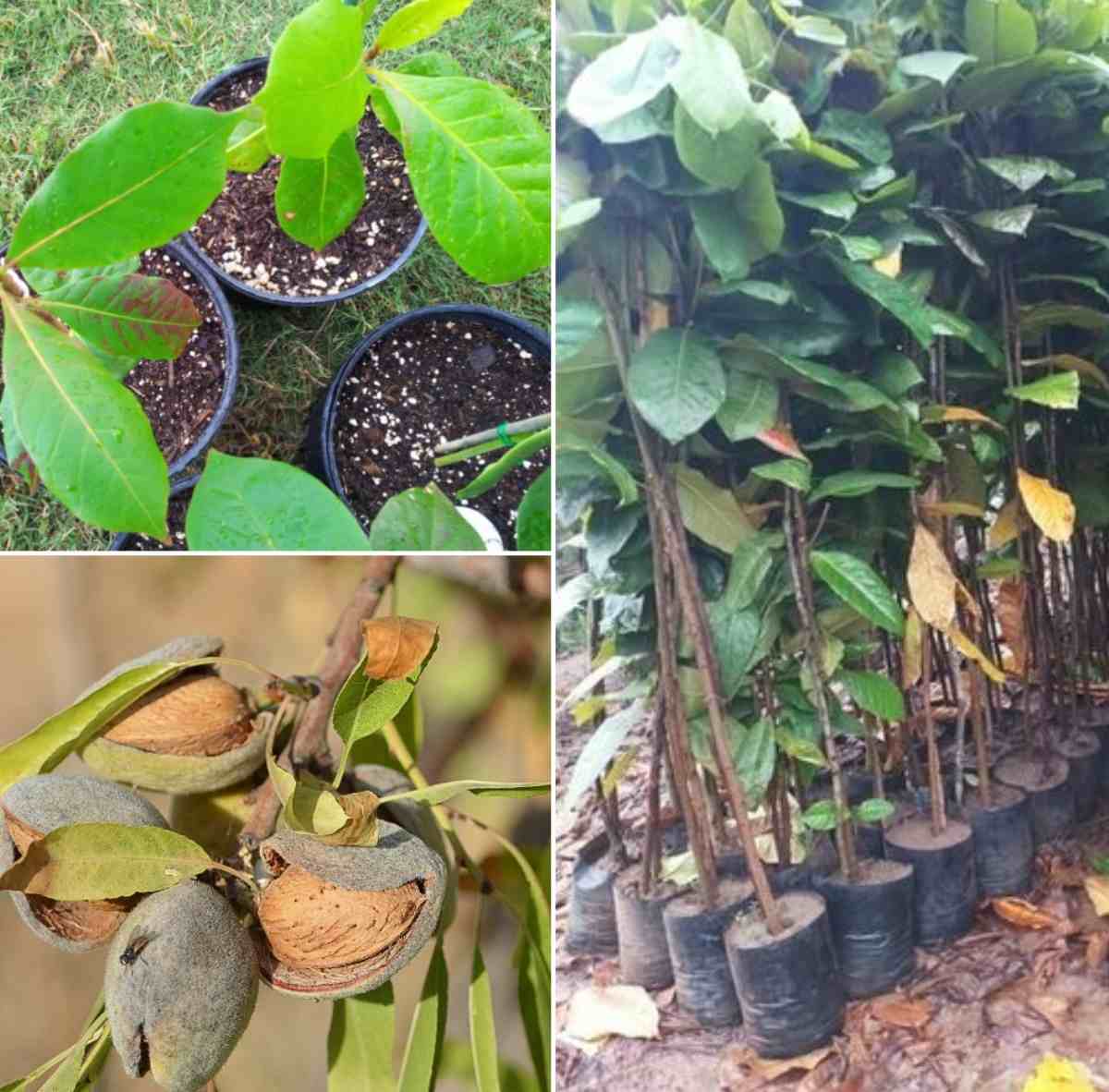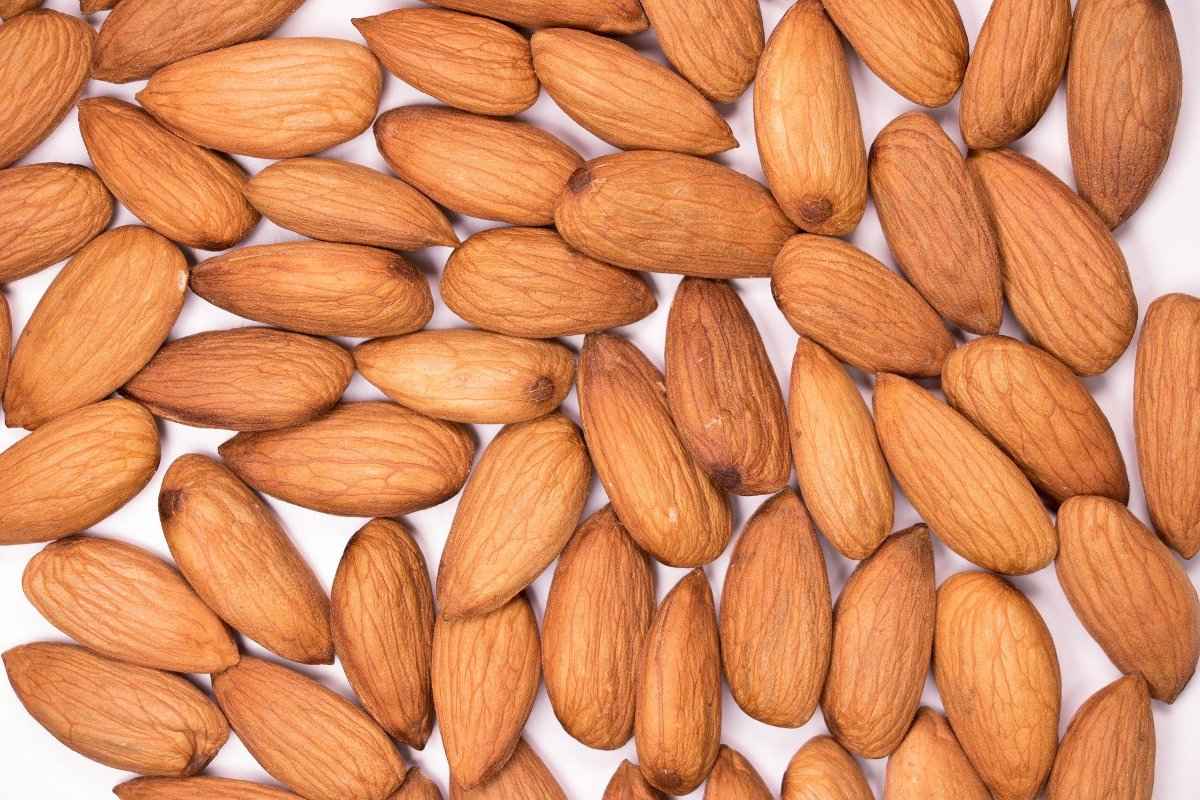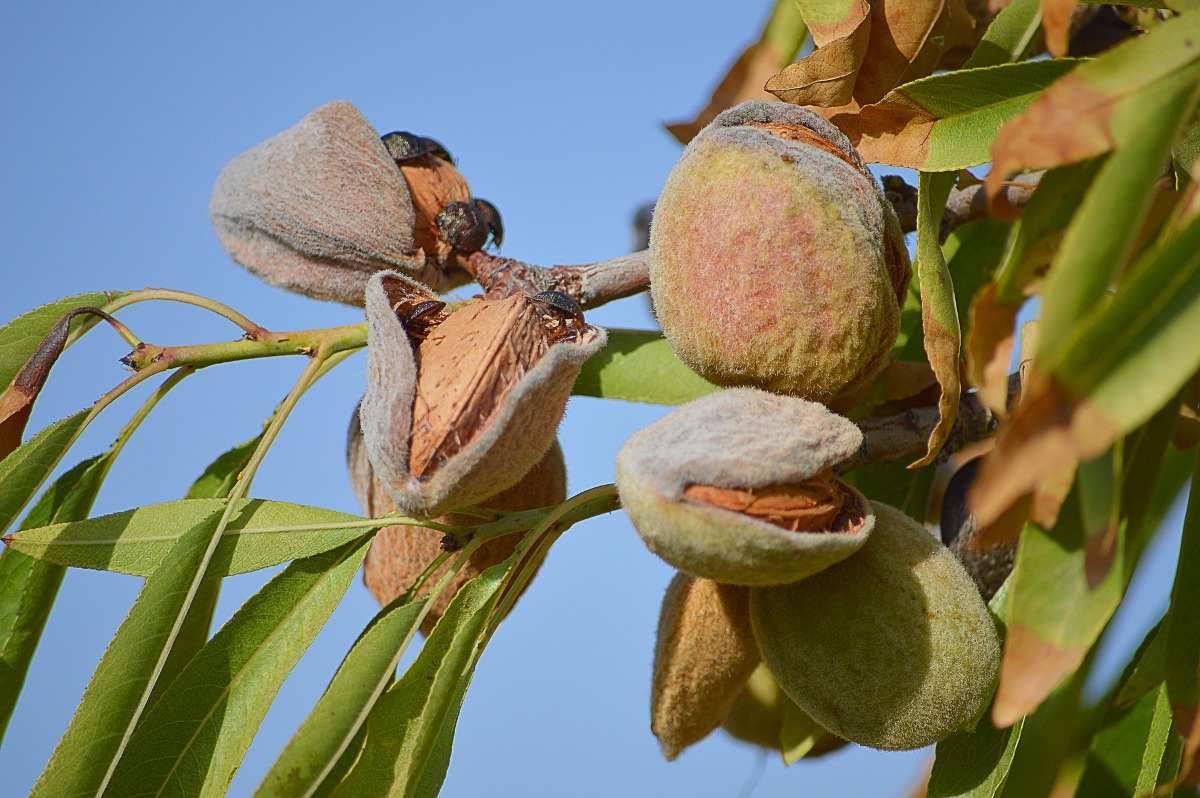Badam seed germination (Almond): The Almond or Badam is a species of Prunus belonging to the subfamily Prunoideae of the family Rosaceae. These are the healthiest and most nutritious nuts of all, considered a well-balanced cholesterol free food. Almonds can be finicky plants to develop; without a suitable climate or proper care, Almond trees may struggle to survive, let alone bear fruit. These Almond trees are susceptible to spring frost, require wet soils, and bloom only in cold, rainy weather. Almonds are not only delicious but also extremely nutritious as well. Most orchard Almond trees are propagated through grafting, but you can also germinate Almonds at home for consumption or also later planting.
The selection of a site for an Almond should have proper soil and air drainage and must be free from a hail storm and frost in the spring. The climatic requirements of this nut are exacting than any other fruit. Even in well recognized Almond areas certain sites are well adapted and give excellent results. The tenderest stage in Badam is blossoming and the development of young fruit is shortly after dropping off the husk. The blossoms become more and tenderer on opening. In this article we also discussed below topics;
- Can you grow an Almond tree from an Almond
- Process of growing Almond from seed
- Time to take Almond seeds take to germinate
- How do you germinate Almond seeds
- Almond seed germination temperature
- Process for germinating Almond seeds
- Almond seeds germination period
- Germinate Almond seeds indoors
A step by step guide to Almond seed germination

Conditions for Almond seed germination
Almond trees thrive in a climate that has mild, wet winters and hot, dry summers. Almond trees grow best on deep loam soils consisting of clay, sand, humus or other organic material. This soil allows for optimal permeability, water retention, and root zone aeration. When preparing to plant a new Almond orchard, growers cultivate the soil to loosen clods and grade the orchard. It is common practice to use a chisel attachment to dig deep down and break up any hardpan below the surface of the soil to help newly planted trees establish a deep root system.
Seeds from Almond and other Rosaceae species need a cold treatment under humid conditions to overcome the dormancy and promote their germination. Temperature is a major factor affecting the germination rate. The temperature range between 2ºC and 7ºC is generally the most efficient.
You should not miss the Future of IoT in Agriculture in India.
Almond trees are not self-pollinating and need bees for pollination. The nuts will grow and develop for approximately 4 months through the summer. Most of the new orchards use drip or sprinkler irrigation systems. These systems allow for greater conservation of water and control of run-off. The frequency of water application during the growing season depends on the age of the orchard, the levels of precipitation in the region, and weather conditions. Drought conditions have a little negative impact on Almond trees. In fact, most trees benefit from some drought stress. Under dry conditions, the hulls split more uniformly and less likely to rot. A dry growing season will result in an early harvest.
Deep, loamy, well-drained soils are ideal for Almond growing but can be grown in average soils supplemented with FYM (farmyard manure) and assured irrigation system. Almond trees do not thrive well in heavy or poorly drained soils.
For the production of the healthy and preferred size of rootstocks, nuts from freshly harvested dried bitter Almonds are preferred. The Almond seeds are first stratified by keeping in moist sand from November to March at the coolest shady place. This treatment releases the dormancy and plant seeds are ready to germinate during March. The germinated seeds are normally sown in the nursery beds in line at 10cm spacing (plant to plant) and 45cm between row to row. The young seedlings must be regularly irrigated and given nitrogen fertilizers during summers for getting the desired size (pencil size thickness) of rootstocks in the same year. These plants are ready for budding during the month of July to the first week of August.
Standard germination and planting for Almond
You can germinate Almond seed for planting simply by soaking and planting them. Because some of the seeds can be infertile or become moldy, use more Almonds than you intend to plant. Then, place a few Almonds in their shells in water overnight. In the morning, remove the seeds from the water and crack the shells with a nutcracker. Do not remove the shell and just open the seed at the seam. Place the Almonds on their sides in a small container of soil and put them in a sunny area indoors. Keep the soil damp at all times. Because Almonds fall from the tree in fall and sprout in spring, it may take several months for sprouts to appear above the surface of the soil.
An easy method to germinate Almond seeds to tree
You can easily grow an Almond tree at home from raw Almonds available in the kitchen. You should use unsalted and unroasted Almonds.
Almond seeds are not so easy to germinate especially in the tropical climate. Almond seed germination is not an easy job if you are not aware of the stratification of the seed process.
Stratification is a procedure of treating seeds to simulate natural conditions that the seeds should experience before germination can occur. The commonest problem is the fungus attack on the Almond seed after sprouting and after transplanting.
Purchase seeds or seedlings. You have two options for starting an Almond tree you can either use seeds (fresh, unprocessed nuts) or seedlings (young trees). Nuts allow you to experience the growing procedure from the very beginning but can be more time and effort-intensive. On the other hand, seedlings are more convenient but can be more expensive.
If you want to harvest edible Almonds, you’ll want to be sure to pick seeds for a fruit-bearing sweet Almond tree. Keep in mind that bitter Almonds are inedible and not all sweet Almond trees bear fruit. These varieties are suitable for shade and decoration.
Effects of stratification in Almonds
You can speed up the average sprouting time of Almonds by stratifying them to simulate winter conditions. This kind of treatment increases the percentage of successfully germinated seeds. To stratify the seed, soak it and place it in the refrigerator at 34 to 40F for one to two months. Keep the Almond seeds damp at all times. The seeds must begin to germinate within a few days after planting. And you can “field-stratify” Almond seeds by soaking them overnight and planting them outside in the soil in fall. The seeds will not grow until spring, but the stratification procedure greatly increases the rate of germination.
Grow an Almond from seed
First, fill a container with tap water and put at least a dozen Almonds into it. Allow them to soak for at least 8 hours and drain them. By using a nutcracker, partially crack the Almond shell to expose the interior nut and don’t remove the shell. Then, arrange the nuts in a container lined with a damp paper towel or sphagnum moss and cover the container with plastic wrap to retain moisture. Place the container of nuts into the refrigerator for 2 to 3 months, checking each week to be sure it is still moist inside. This procedure is called stratification.
You may also check the Date Palm Seed Germination, Time, Temperature.

Stratification is tricking the Almond seeds into believing they have gone through winter. It boosts the germination rate of seeds which generally germinate within a few days of planting. Seeds can be “field stratified” by soaking them overnight and then planting outside in the fall. The seeds will not grow until spring, but the stratification will increase their rate of germination. Once the Almond seeds have been stratified, fill a container with potting soil. And press each seed down into the soil and inch (2.5 cm.) or so. Water the seeds and put the container in a warm, sunny area. Water once a week or when the soil feels dry about 1 ½ inch (4 cm.) down into the soil. Transplant the plants when they are about 18 inches (46 cm.) in height.
Process of Almond seed germination;
If you’re growing Almond tree from a seed (which are just Almond nuts surrounded by their protective husks), start by germinating the seed in a controlled environment once it’s started, and you can plant it in a pot or in the ground. First, gather seeds in a single large bowl (the more you use, the better some may not sprout or may succumb to mold). Then, germinate them according to the below steps;
- Add water and let the Almond seeds soak overnight.
- The next day, use a nutcracker to crack the Almond shells open slightly and the shell should still hold itself together, but you should just be able to see the nut inside. And throw away any seeds that show signs of mold.
- Fill a few small flowerpots with potting soil and make sure the pots have holes on the bottom for drainage.
- Plant the Almond seeds an inch or two under the surface of the soil with the cracks pointing upward. Rest the flowerpot indoors in an area that will receive direct sunlight and then wait for seedlings to sprout.
Sprouting Almonds for consumption
Like other seeds, Almonds have enzyme inhibitors, chemicals that help keep them dormant until growing conditions are correct. And these substances can make Almonds more difficult for humans and primates to digest. Germinating Almond seeds before eating them reduces the levels of enzyme inhibitors present and makes the nuts easier to digest. This procedure requires an overnight soak, followed by rinsing and soaking again for about 24 hours. Then, the Almonds swell but do not sprout fully.
Transplant the almond sprouts
Once your seedlings have started to produce (or, alternatively, if you bought ready-to-plant seedlings), prepare a decided-upon spot in the ground for planting. Make a small mound an inch or 2 tall (and slightly wider than it is tall) for each seedling. Push the seedling about an inch into the center of the mound until it’s below the soil surface. This mound method helps prevent water from gathering around the roots of the plant as it grows, which can cause serious problems (including root rot).
If you’re planting germinated seedlings, then plant them at the end of winter or in the spring. Otherwise, if you’re planting un-germinated seeds, plant them in late fall so that they have a chance to sprout in the spring at the start of the bloom season. If planting multiple trees, space each tree at least about 20 feet or 6.1 m apart. This gives the trees’ roots plenty of space and allows for an easy, effective irrigation system.
Almonds seed quality consideration
You can germinate raw, unroasted Almonds. All Almonds must be pasteurized to reduce the risk of Salmonella contamination, including those labeled as “raw.” This procedure prevents the Almonds from sprouting correctly. The way to germinate Almonds at home is to acquire truly raw seeds from a farmer or someone else who owns an Almond tree. And nuts purchased from stores are unlikely to sprout properly, whether you intend to eat them or grow an Almond tree.
Care of Almond trees
Almond tree care changes according to the season. In the winter season, the growing Almond trees should be pruned (December/January) to promote growth, allow light, and remove any dead or diseased limbs. For eliminating overwintering navel orange worms you just clean the area of debris around the Almond tree and spray with dormant oil to kill peach twig borer, and mite eggs. During the spring bloom season, care of Almond trees must contain fertilization of mature trees with urea or manure, watered in, or small doses of nitrogen for young trees.
Harvesting Almond tree fruit
In Almond production, time of harvest depending on location. Normally, they are ready for harvest when the hull color changes from green to yellowish with cracks or splitting at suture starting from the pedicel end. Under premature harvest conditions, the hulls remain as stick-tights and it needs more energy to dislodge the nuts, resulting in damage to limbs in the form of wounds. Nuts must be placed at a shady place for drying and removing hulls.
You may also like the Seed Subsidy Schemes for Farmers in India.
The harvesting of Almond fruit occurs after the hulls split and the shell becomes dry and brown in color. Almonds require 180 to 240 days for nuts to mature wherein the nut (embryo and shell) has dried to minimum moisture content. To harvest the Almond, shake the tree, and then separate the hulls from the nut. Freeze your Almond nuts for 1 to 2 weeks to kill any residual worms and then store in plastic bags. Finally, when caring for Almond trees, spray the trees during or after the leaves drop in the fall before the winter rains. Then this will reduce the damage from shot hole fungus in the spring.
Frequently asked questions about Almond seed germination

How long does it take for Almonds to sprout?
Almonds soak for about 12 to 24 hours and then sprout for 2-3 days.
How many Almonds does an Almond tree produce?
A healthy tree can produce over 40 pounds of nuts in a single harvest. Once the tree begins bearing fruit, it will do so every year for as long as 50 years, ensuring plenty of Almonds for years to come.
Do Almond trees need pruning?
Pruning Almond trees take place again when the tree is dormant in its second growing season. At this time, the Almond tree will likely have several lateral branches. And, remove narrow angled secondary branches when almond tree pruning second-year trees.
How much space does an Almond tree need?
Space your almond trees 15 to 20 feet apart.
Conclusion of the seed germination process of Almond
Healthy seed germination conditions will result in quality almond seedlings for plantation. The above-said information will be useful if you are growing almonds on a commercial scale in open fields or even in the home garden such as backyards, plant nurseries. In case if you miss this Growing Guava in Pots from Seeds and Cuttings.
good information